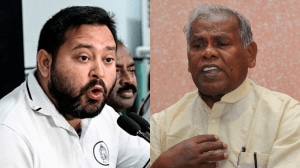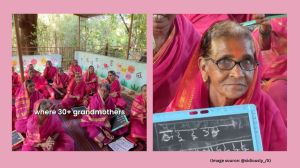How women’s reservation first came about at the Panchayat and municipality level — and the challenges on the ground
Research showcases the limitations of the law when it comes to implementation on the ground, with prevailing gender norms and reception towards seeing a woman leader.
 Women from various oganisations sit on a 'dharna' at Parliament Street in 2010 demanding the Women's Reservation Bill be passed in the Lok Sabha in the curent session *** Local Caption *** Women from various oganisations working for the right of Muslim women in India sit on a 'dharna' at Parliament Street on Thursday demanding the Women's Reservation Bill be passed in the Lok Sabha. (Express Archive)
Women from various oganisations sit on a 'dharna' at Parliament Street in 2010 demanding the Women's Reservation Bill be passed in the Lok Sabha in the curent session *** Local Caption *** Women from various oganisations working for the right of Muslim women in India sit on a 'dharna' at Parliament Street on Thursday demanding the Women's Reservation Bill be passed in the Lok Sabha. (Express Archive) The lead for securing Women’s Reservation was first taken up in the local administrative bodies.
Started in Bihar in 1948, the panchayat system has existed since the early 1950s. But it largely remained non-functional until the 1990s. The 73rd Amendment in 1992 sought to change the framework and established a three-tiered panchayat system with regular elections throughout India. It also mandated that “one-third of the total number of seats reserved under clause (1) shall be reserved for women belonging to Scheduled Castes or, as the case may be, the Scheduled Tribes”. Additionally, it said that “no less than one-third (including the number of seats reserved for women belonging to the Scheduled Castes and the Scheduled Tribes) of the total number of seats to be filled by direct election in every panchayat shall be reserved for women and such seats may be allotted by rotation to different constituencies in a panchayat.”
The 74th amendment proposed similarly to the case of urban local bodies such as municipal corporations, municipal councils and nagar panchayats.
In 2009, the Constitution (110th Amendment) Bill was introduced in the Lok Sabha to increase reservation for women from one-third (33%) to one-half (50%) of the total seats in panchayats. The Bill, however, was never passed.
In 2006, Bihar became the first state to increase the reservation percentage to 50%, under CM Nitish Kumar.
Sikkim followed suit and implemented a 40% reservation policy in panchayat elections for women in 2008 (it stands at 50% now).
Chhattisgarh, Madhya Pradesh, Rajasthan and Uttarakhand subsequently passed laws to increase reservation for women in panchayats to 50%. At present, 20 states, including Madhya Pradesh, have 50% reservations for women at the panchayat level.
Several studies since then have shown how the changes have paved the way for the election of around 1 million women at village, block and district levels, and the impact of the same.
A 2003 study published by the Massachusetts Institute of Technology (MIT) called it “a landmark piece of legislation as well as, to some extent, a test case”. It went on to say: “Women in villages with reserved pradhans are twice as likely to have addressed a request or a complaint to the gram pradhan in the previous six months, and this difference is significant.”
A 2010 study published by the India Policy Forum, organised by the NCAER, noted that “villages with female leaders experienced increased female participation and responsiveness to female policy concerns”. The study also found that “village councils with reserved female leaders invested more in drinking water infrastructure, sanitation, roads, school repair, health centre repair, and irrigation facilities”.
A 2012 paper published by the International Growth Centre, a joint initiative by the London School of Economics and Oxford University, on health outcomes at the panchayat level in Bihar and Jharkhand, pointed out that “political decentralization is positively associated with higher probabilities of institutional births, safe delivery, and births in government health facility”.
But research also showcased the limitations of the law when it comes to implementation on the ground, with prevailing gender norms and reception towards seeing a woman leader.
The MIT research noted that 43% of the women interviewed acknowledged being helped by their spouse. And that, even if they were contributing to work at their village level, they would largely remain “hesitant”. The researchers attributed this to “the impression that women are not effective leaders”, stemming from “the social perceptions of women that the policy precisely tries to address”.


- 01
- 02
- 03
- 04
- 05





























